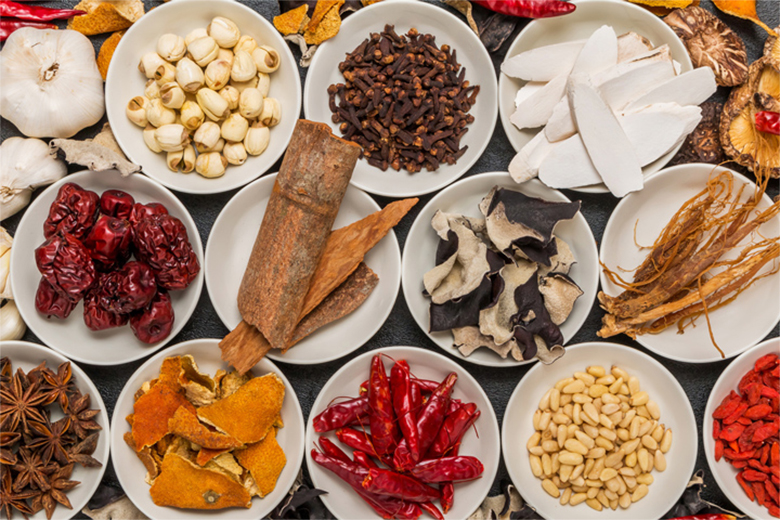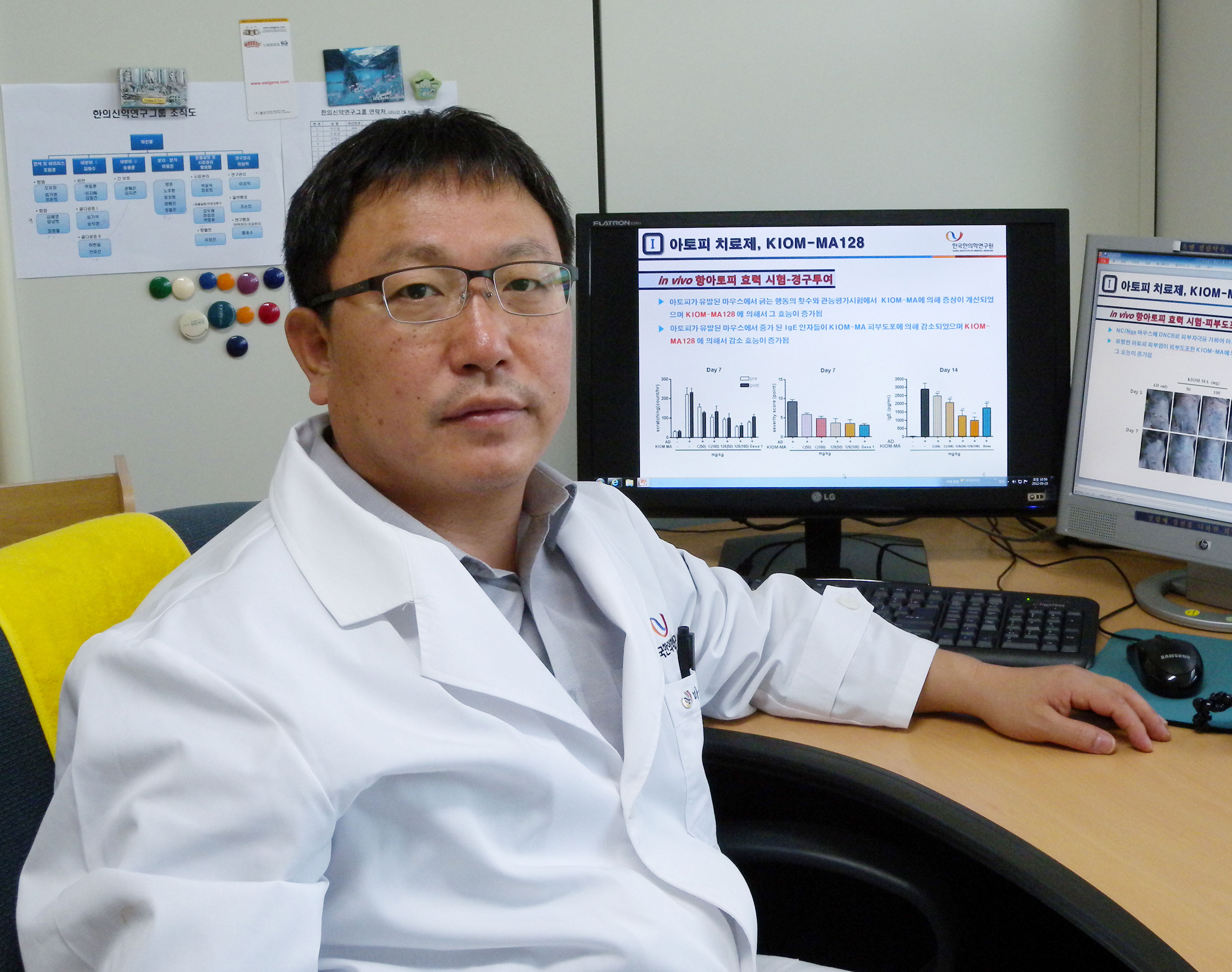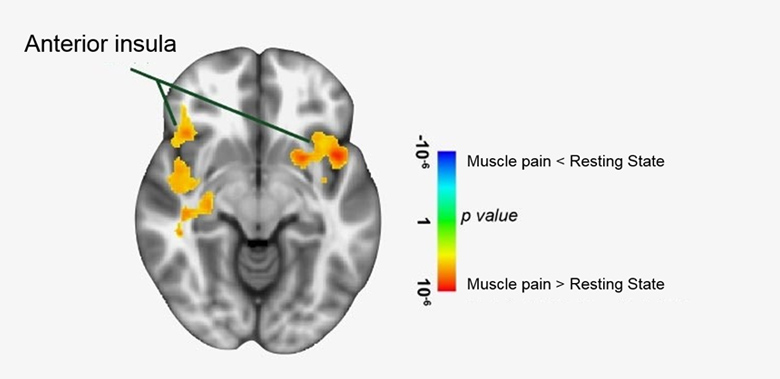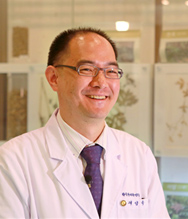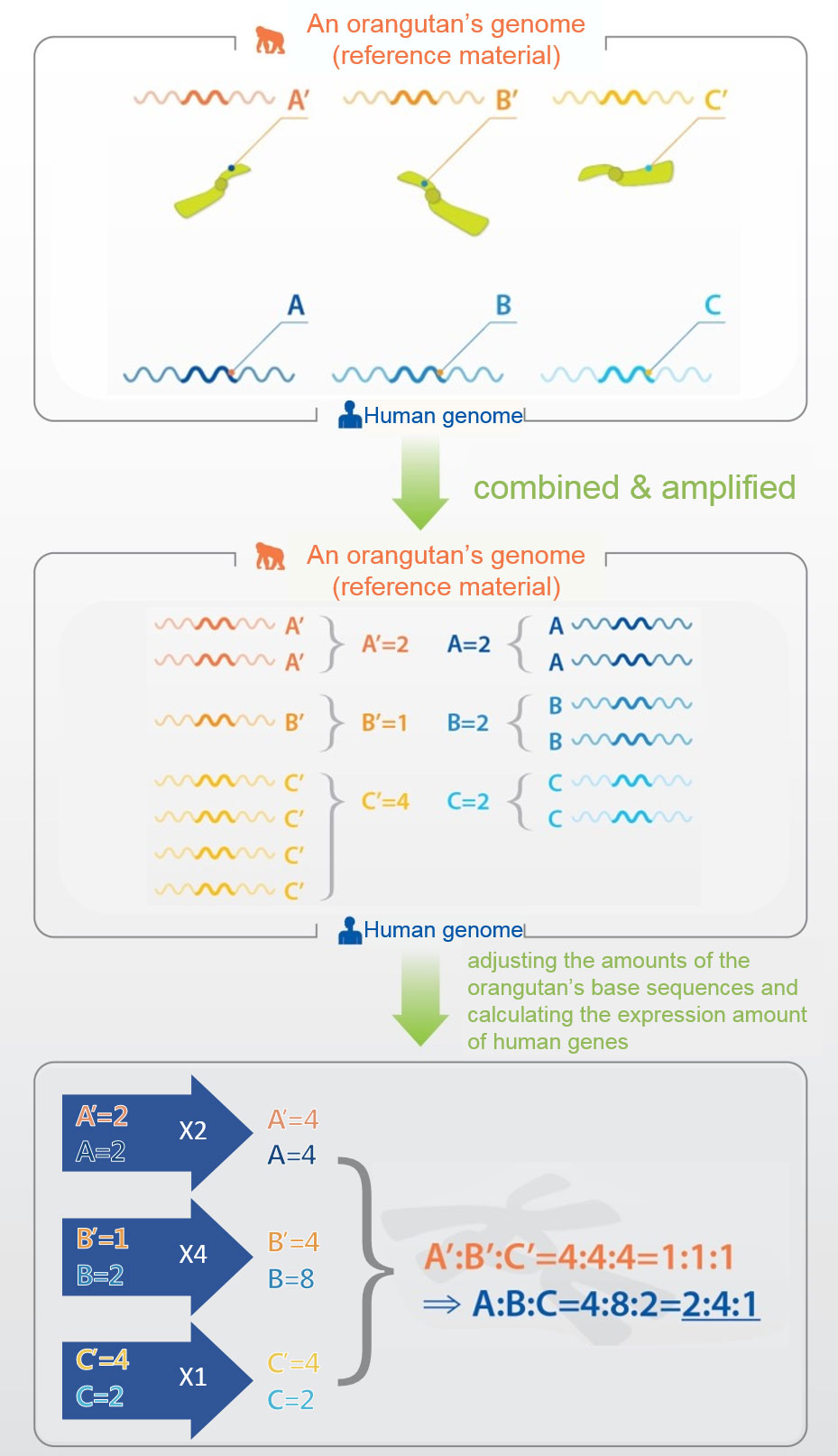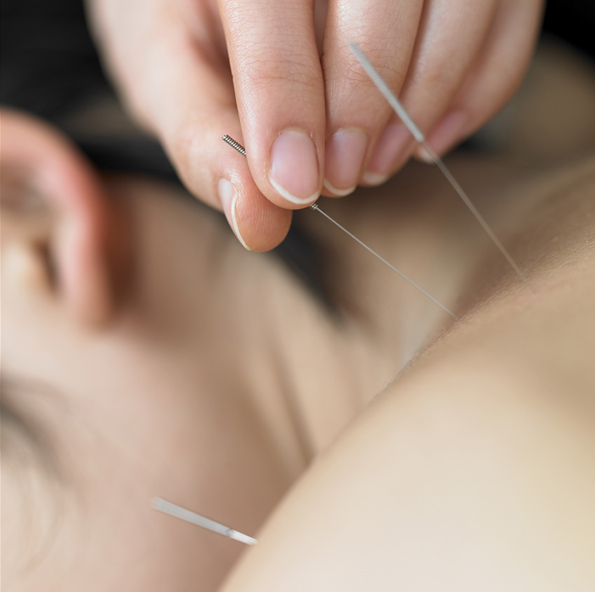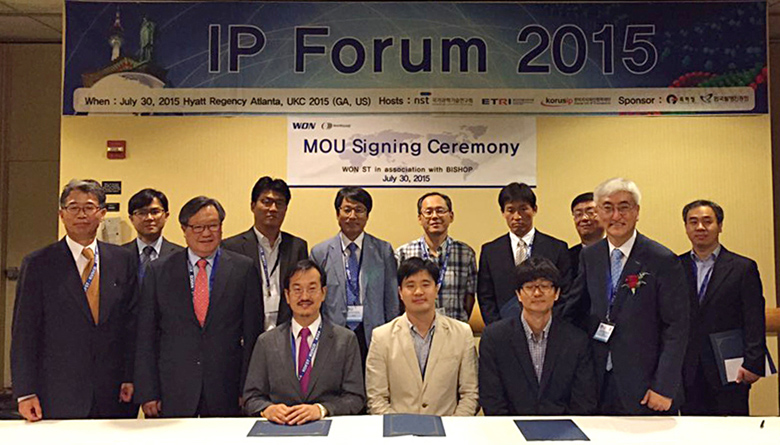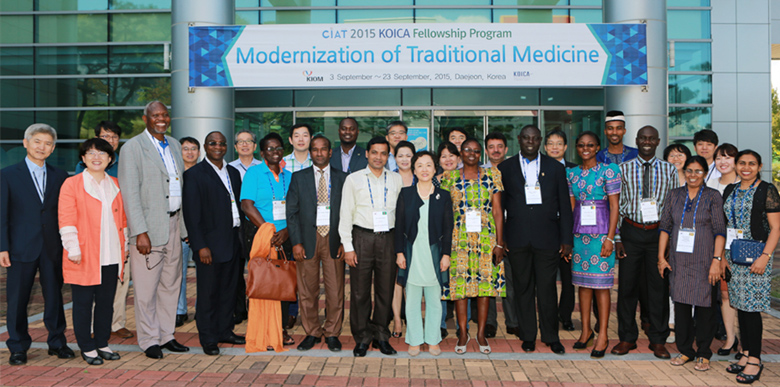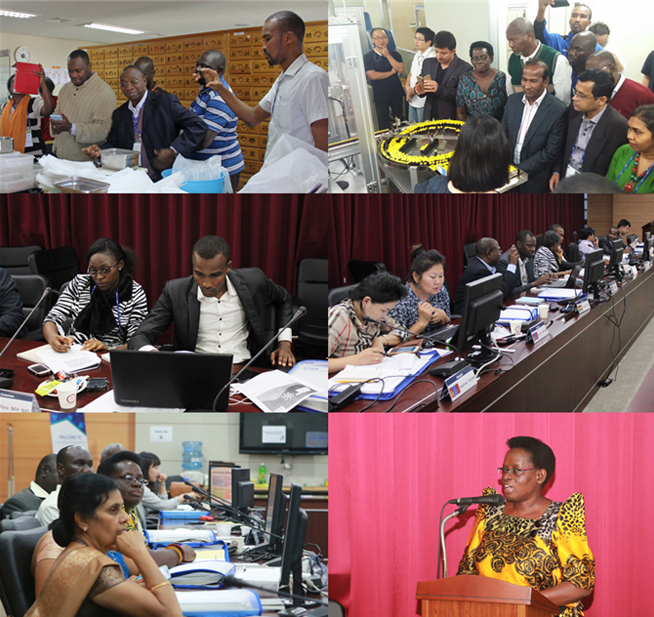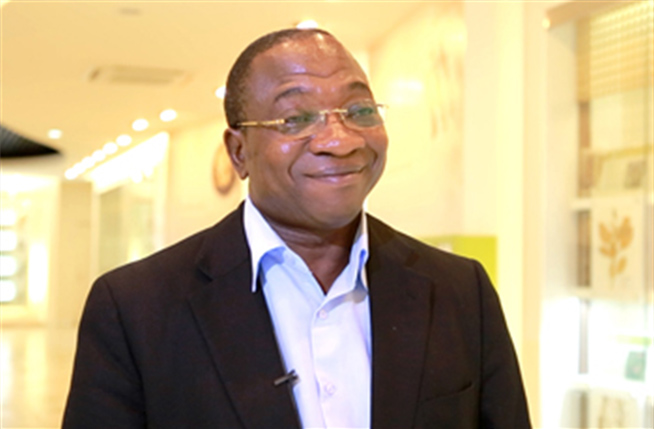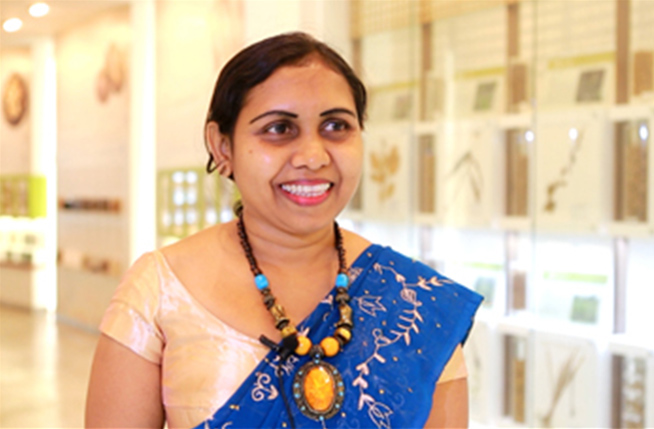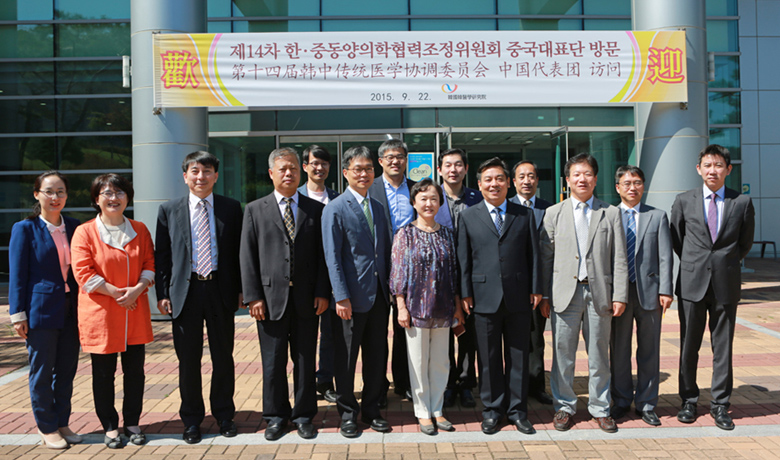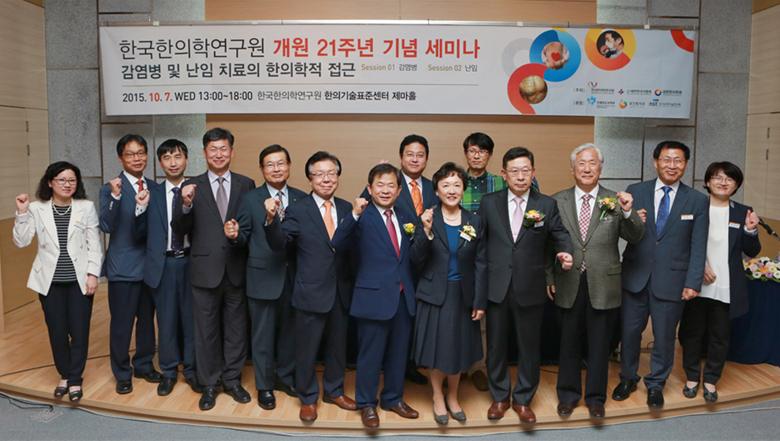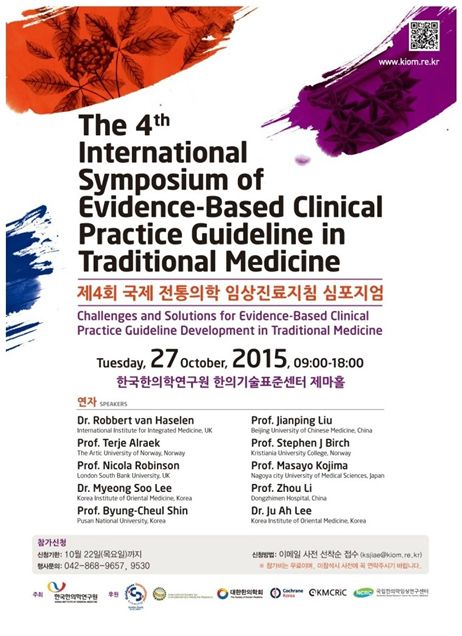
|
||||||||||||||||||||||||||||||||||||||||||||||||

|
||||||||||||||||||||||||||||||||||||||||||||||||


|
||||||||||||||||||||||||||||||||||||||||||||||||
|

Development of substance for cosmetics based on medicinal herbs
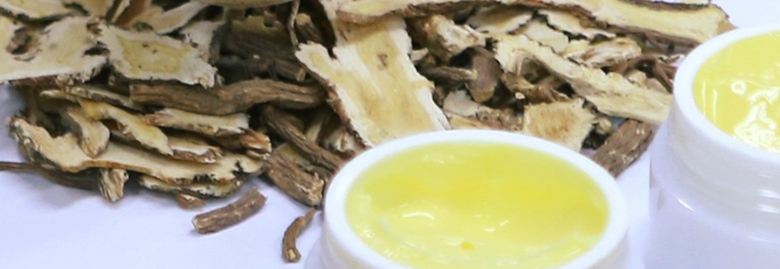
|
'Cosmeceutical' is a word newly coined by combining cosmetics and pharmaceutical, meaning cosmetics with enhanced professional treatment effect due to the addition of medically proven substances, and it is currently drawing heated interest in the cosmetics industry.
A research team led by Dr. Chae Sung Wook at KM Convergence Research Division in KIOM developed a herbal-based substance that inhibits skin inflammation more effectively than those currently in the market. The technology on the substance was transferred at an advance royalty of 1.7 hundred million KRW, and is likely to create high added values in the cosmeceutical market. 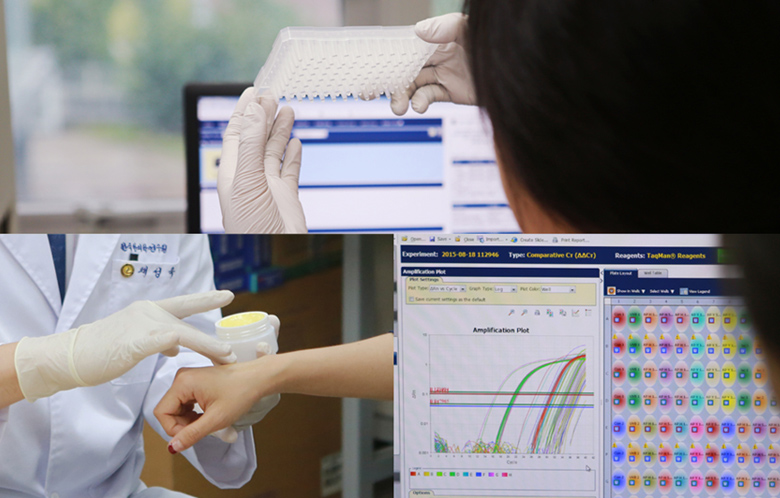
In the cell experiment, Dr. Chae's team observed the skin aging of subjects after dividing them into the no-treatment control group and the test group, and then further dividing the test group into the UV-treated group whose skin aging was induced and the sample-administered group whose members were treated with the test sample after the UV treatment. The test results showed that the expression of IL-1b and IL-8, genes that induce inflammations related to skin aging, was inhibited in the sample-administered group compared to the UV-treated group by 96% and 60%, respectively. Also, the substance was seen to reduce the expression of MMP (Matrix Metalloproteinases), a collagenase that accelerates aging by degrading collagen, by 96% and increase the expression of TIMP (tissue inhibitor of metalloprotease), which generates new collagen, by around 300%. Skin aging progresses when MMP, which helps degrade collagen, is activated, expediting protein degradation and leading to chronic skin damage. The new substance has been confirmed to improve skin aging by inhibiting the expression of genes inducing inflammation and an enzyme related to skin aging, while increasing an enzyme that generates new collagen. In addition, the research team has proven the safety of the substance through a skin safety test at Dermapro, an organization that evaluates safety and efficacy of cosmetics and cosmeceuticals. The human skin primary irritation test conducted at Dermapro revealed that there were no side effects. In the Korean cosmetics market, which is estimated to reach 12.6 trillion won, cosmeceuticals are currently considered to take up just 3% to 4%, compared to the U.S. market where cosmeceuticals have about 20% of the market share. Thus, it is seen that the cosmeceutical market has a high growth potential. The technology on the new substance was transferred to Hansol Bio at an advance royalty of 1.7 hundred million KRW (running royalty: 3.3% of net sales), and it is expected to create high added values in the cosmeceutical market in the future.
|

|
|
If the numbers of base sequences after the amplification are 2 (A'), 1 (B'), 4 (C'), 2 (A), 2 (B) and 2 (C), we can see that the amount of expression of human genes (A:B:C) is 2:4:1 by adjusting the amounts of the orangutan's base sequences A', B' and C' to the same value of 4 and calculating the expression amount of human genes.
The technology turned out to yield high accuracy (less than 5% error range) and reproducibility (above 95%). As the accuracy in comparing the amounts of expression of different genes leads to high applicability, the technology is considered to open a new possibility in the study of genome in the future. The research team will use the technology to understand the features of the expression of specific gene clusters related to Mibyeong (Subhealth in Korean Medicine. ) The result of the research was published in the July issue of the online version of 'Scientific Reports' (impact factor: 5.578), a sister journal of 'Nature.' Principal Researcher Jeong commented, "The technology, which enables comparative analysis of the expression amounts of different genes, can be used in various ways in the field of healthcare by evaluating people's health, diagnosing diseases, predicting prognosis, etc." |

|
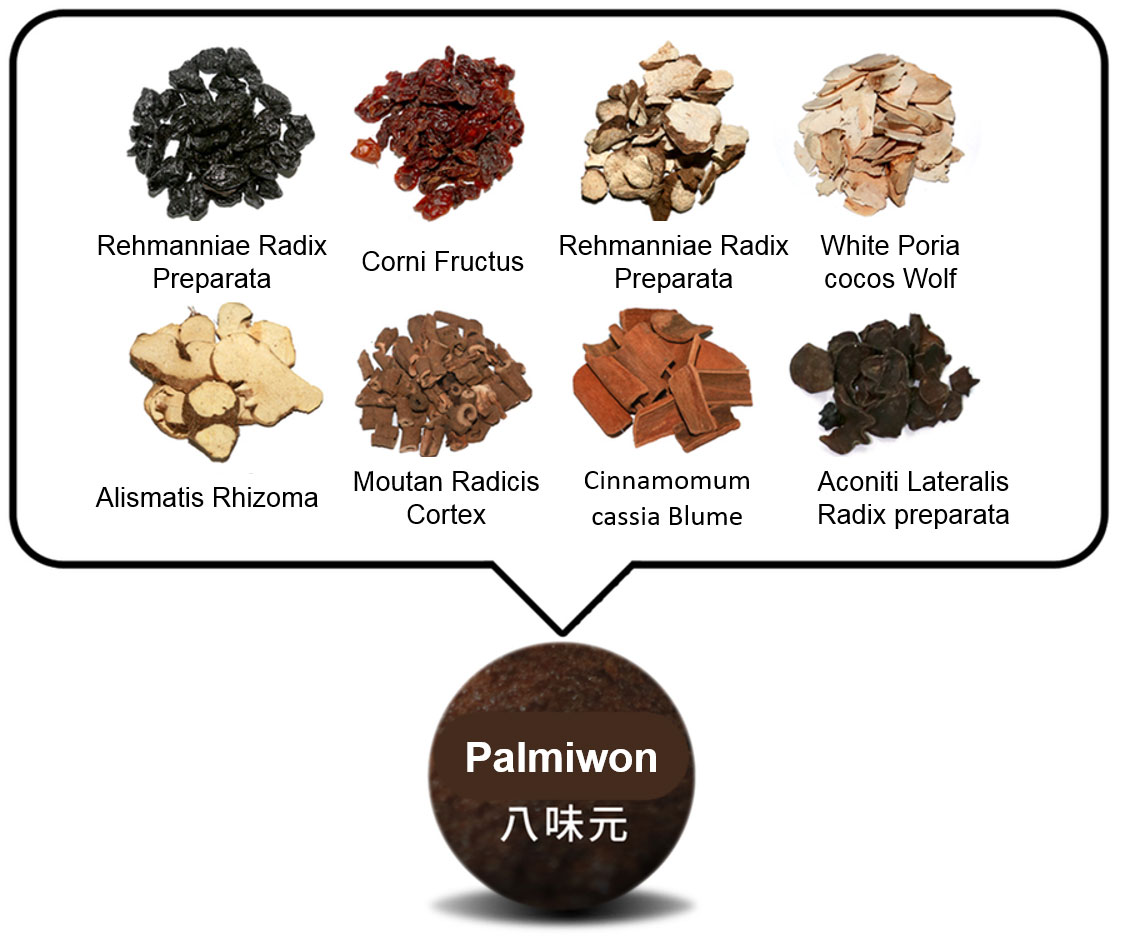 Dr. Ko Byoung Seob's team at KM Convergence Research Division in KIOM has scientifically proven the effects of Palmiwon, a prescription used in Korean Medicine, on the improvement of dyslipidemia related to menopause and published the research result in an SCI-level international journal.
In the animal test, Palmiwon was discovered to increase high density lipoprotein cholesterol in serum lipid by 47.5% and decrease triglyceride and low density lipoprotein cholesterol by 57.6% and 30.1%, respectively, thereby improving atherogenic index by about 56.3%. |
* Triglyceride (TG), total cholesterol and low density lipoprotein (LDL) cholesterol enhance the risks of heart attack and stroke, whereas high density lipoprotein (HDL) cholesterol reduces these risks.
Female hormone deficiency during menopause leads to menopausal syndrome over a long period, causing relatively mild symptoms such as facial blushing, muscle pain, arthralgia and dyslipidemia as well as life-threatening symptoms including osteoporosis and arteriosclerosis.
Notably, many menopausal women are known to suffer from dyslipidemia. In this case, the risks of cardiovascular diseases such as arteriosclerosis, in which the blood vessels become narrow due to the buildup of cholesterol, increase, requiring the effective prevention and treatment of cardiovascular diseases caused by dyslipidemia during menopause.
* Dyslipidemia refers to the condition in which the levels of total blood cholesterol, LDL cholesterol and triglyceride have increased or the level of HDL cholesterol has decreased, and it enhances the risks of obesity and diabetes as well as cardiovascular diseases including arteriosclerosis and myocardiac infarction.
Notably, many menopausal women are known to suffer from dyslipidemia. In this case, the risks of cardiovascular diseases such as arteriosclerosis, in which the blood vessels become narrow due to the buildup of cholesterol, increase, requiring the effective prevention and treatment of cardiovascular diseases caused by dyslipidemia during menopause.
* Dyslipidemia refers to the condition in which the levels of total blood cholesterol, LDL cholesterol and triglyceride have increased or the level of HDL cholesterol has decreased, and it enhances the risks of obesity and diabetes as well as cardiovascular diseases including arteriosclerosis and myocardiac infarction.
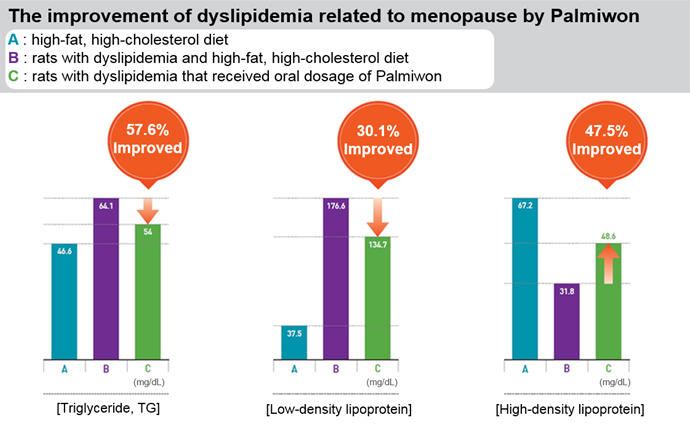
Dr. Ko Byoung Dr. Ko's team induced menopause in rats by excising ovaries and caused dyslipidemia using high-fat, high-cholesterol diet.
The test rats with dyslipidemia were divided into two groups, including the test group that received oral dosage of Palmiwon daily for eight weeks and the control group that did not. The two groups were observed with a focus on the degree of improvement in dyslipidemia and atherogenic index. |
The test results showed that the levels of TG and LDL cholesterol concentration dropped by 57.6% and 30.1%, respectively, while the concentration of HDL cholesterol increased by 47.5%.
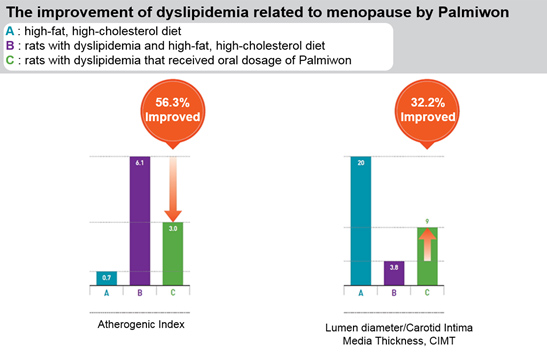 In addition, the team analyzed the atherogenic index, which indicates the risk of arteriosclerosis, and the lumen diameter/carotid intima media thickness (CIMT) based on the effects.
The atherogenic index appeared to have improved in the test group administered with Palmiwon by 56.3% and the lumen diameter/CIMT improved 32.2% compared to the control group. |
The research confirmed the effects of Palmiwon on dyslipidemia including the improvement in the atherogenic index, providing scientific basis of the efficacy of the Korean medical prescription.
The research result was published in 'Menopause' (impact factor: 3.361), a journal of the North American Menopause Society.
The research result was published in 'Menopause' (impact factor: 3.361), a journal of the North American Menopause Society.
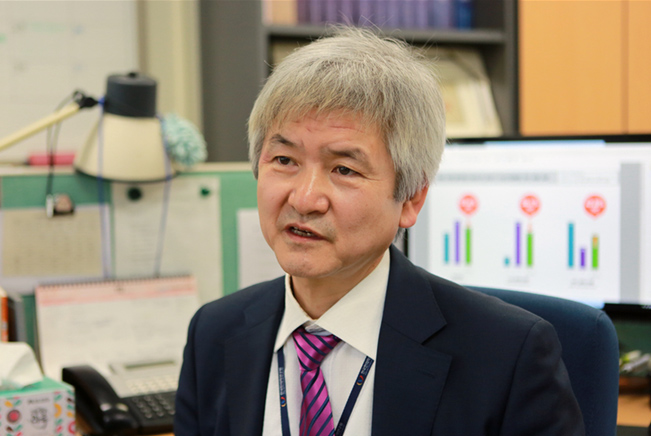 |
Principal Researcher Ko said, "The efficacy of Palmiwon has been scientifically proven, and it can be used as clinical basis for the prevention and treatment of arteriosclerosis in menopausal women in Korean traditional medical clinics and hospitals. We will continue to prove the efficacy of Korean traditional prescriptions and establish their scientific basis, while contributing to the health of the elderly in the age of centenarians."
|

|


for use as university textbooks in the U.S. |
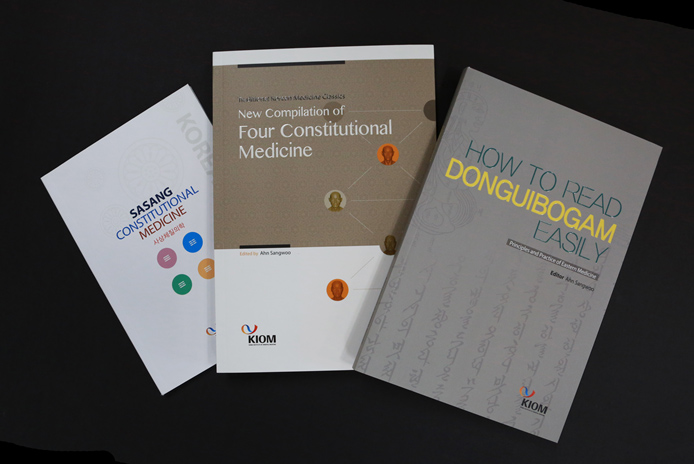 Three books on Korean medicine published in English by KIOM will be used as university textbooks in the Dongguk University Los Angeles (DULA) in U.S., where they are expected to contribute to enhancing awareness on Korean medicine.
The three books are 'How To Read Donguibogam Easily', 'Sasang Constitutional Medicine' and 'New Compilation of Four Constitutional Medicine.' |
KIOM published the 'How To Read Donguibogam Easily' in 2009, the English version of 'Sasang Constitutional Medicine' in 2010 and the English version of 'New Compilation of Four Constitutional Medicine' in 2011.
'How To Read Donguibogam Easily' covers stories on the life and achievements of Heo Jun, the author of Donguibogam, the historic background and publication process of the literature, and contents of the literature including Naegyeong-pyeon (internal medicine), Oehyeong-pyeon (external medicine), Japbyeong-pyeon (miscellaneous diseases), Tangaek-pyeon (remedies) and Chimgu-pyeon (acupuncture).
'New Compilation of Four Constitutional Medicine.' deals with the introduction on Sasang constitutional medicine and Dr. Lee Je-ma, its founder, how to distinguish different consitutional types, utilization of Sasang constitutional medicine in daily life, etc., and is anticipated to facilitate understanding of the medical field among people unfamiliar with it.
'New Compilation of Four Constitutional Medicine' is an English translation of 'Donguisasangsinpyeon', which provides an excerpt of contents readily applicable to clinical usage from Donguisusebowon, a book written by Won Deok-pil, a medical scientist during the Joseon Dynasty, as well as actual prescriptions used in those days to help optimize clinical usage.
Commenting on the event, President Lee Hyejung of KIOM said, "Utilization of the English introduction on Donguibogam, a book representing Korean medicine, and English versions of books on Sasang constitutional medicine, a medical field distinctively Korean, as textbooks in the U.S. is expected to help enhance understanding of Korean medicine and contribute to its expansion in the U.S. market in the long run."
In addition to the three books published in English, KIOM is engaged in developing various foreign-langue contents for the globalization of Korean medicine such as books for introduction to Korean medicine in English, Spanish and Russian as well as English translation of and English application program for Donguibogam.
'How To Read Donguibogam Easily' covers stories on the life and achievements of Heo Jun, the author of Donguibogam, the historic background and publication process of the literature, and contents of the literature including Naegyeong-pyeon (internal medicine), Oehyeong-pyeon (external medicine), Japbyeong-pyeon (miscellaneous diseases), Tangaek-pyeon (remedies) and Chimgu-pyeon (acupuncture).
'New Compilation of Four Constitutional Medicine.' deals with the introduction on Sasang constitutional medicine and Dr. Lee Je-ma, its founder, how to distinguish different consitutional types, utilization of Sasang constitutional medicine in daily life, etc., and is anticipated to facilitate understanding of the medical field among people unfamiliar with it.
'New Compilation of Four Constitutional Medicine' is an English translation of 'Donguisasangsinpyeon', which provides an excerpt of contents readily applicable to clinical usage from Donguisusebowon, a book written by Won Deok-pil, a medical scientist during the Joseon Dynasty, as well as actual prescriptions used in those days to help optimize clinical usage.
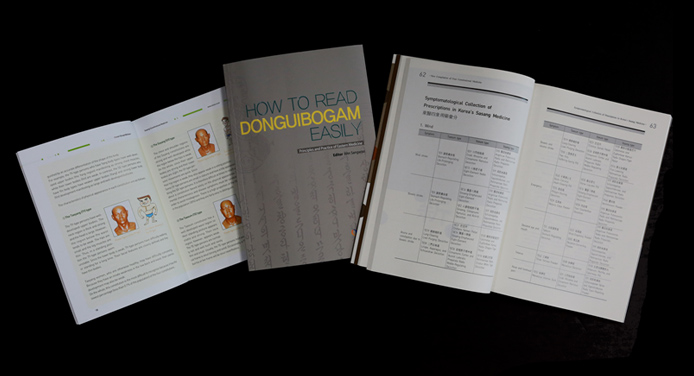 The utilization of these books as textbooks was realized at the request of Dongguk University, whose U.S. campus in Los Angeles had been suffering from lack of English content materials in offering English programs related to Korean medicine.
|
Commenting on the event, President Lee Hyejung of KIOM said, "Utilization of the English introduction on Donguibogam, a book representing Korean medicine, and English versions of books on Sasang constitutional medicine, a medical field distinctively Korean, as textbooks in the U.S. is expected to help enhance understanding of Korean medicine and contribute to its expansion in the U.S. market in the long run."
In addition to the three books published in English, KIOM is engaged in developing various foreign-langue contents for the globalization of Korean medicine such as books for introduction to Korean medicine in English, Spanish and Russian as well as English translation of and English application program for Donguibogam.

|
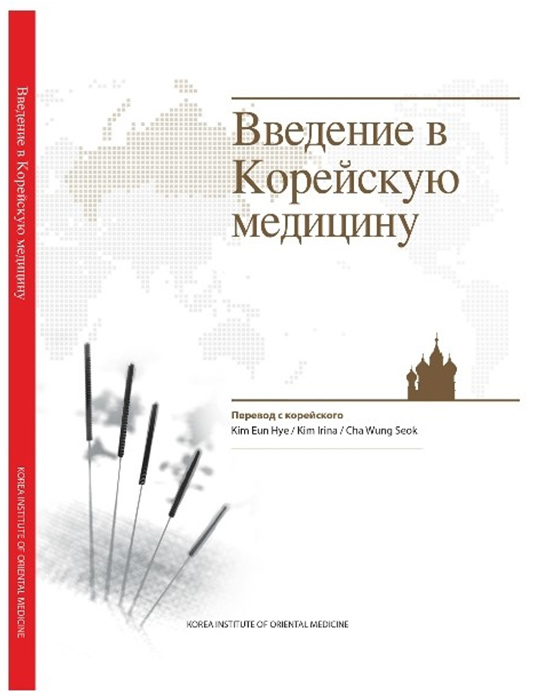 |
An introduction to Korean medicine in Russian is being used as an educational material for the Korean medicine course in a training program for Uzbek healthcare providers.
At present, Korean medicine is advancing actively in Uzbekistan with the Korea-Uzbekistan Friendship Hospital of Korean Medicine being operated and doctors of Korean medicine being allowed to engage in medical practices in the country under the mutual agreement for cooperation in healthcare. In Uzbekistan, healthcare providers are obliged to receive medical retraining. Traditional medicine courses are included in the curriculum, and they have mostly been carried out by doctors of Chinese medicine. |
Recently, as part of the ODA program in Korean medicine sponsored by the Bureau of Traditional Korean Medicine at the Ministry of Health and Welfare and organized by the Industrial-Academic Cooperation Group of Sangji University as well as the Society of Preventive Korean Medicine, a course on Korean medicine was being offered in the Uzbek medical retraining program five days a week from October 12 to 30, using the introduction to Korean medicine in Russian published by KIOM.
KIOM's introduction to Korean medicine consists of five chapters including the characteristics of Korean medicine, medical service system, theories of Korean medicine, treatment methods as well as outstanding figures in Korean medicine and important old books of medicine.
More specifically, it presents the history of Korean medicine, theories on yin and yang, five viscera and six entrails, acupuncture points and meridian system, etc. and various treatment methods such as acupuncture, moxibustion, qigong, chuna, etc.
Notably, explanation on Sasang constitutional medicine, which does not exist in Chinese or Japanese medicine, makes Korean Medicine stand out from those in other East Asian countries.
In July, three English books on Korean medicine published by KIOM started to be used as textbooks in DULA in the U.S., and in 2012, the Mongolian translation of standard meridian point locations by KIOM was distributed and began to be used in Mongolia. Therefore, books published by KIOM are seen as doing their role as essential assets for the globalization of Korean Medicine.

|
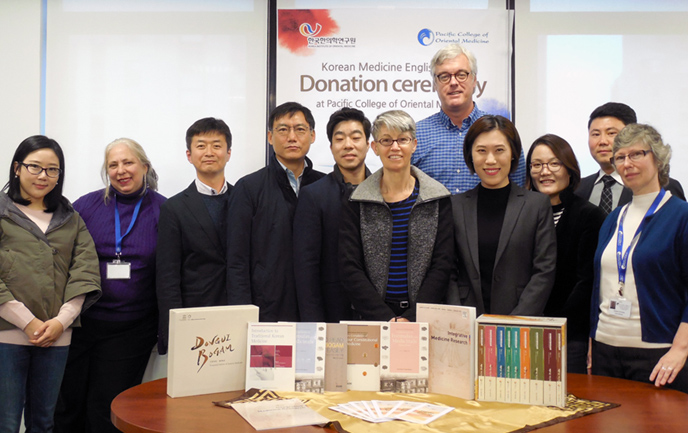 |
'Introduction to Traditional Korean Medicine', 'Donguibogam', 'How to read Donguibogam easily', 'Compilation of Formulas and Medicinals (Bangyakhappyeon)' and 'New Compilation of Four Constitutional Medicine (Donguisasangsinpyeon)' published in English have been donated to an education institution in Korean medicine located in the U.S. to be utilized as educational materials for training experts in traditional medicine.
|
KIOM held a donation ceremony of five English books on Korean Medicine at the Pacific College of Oriental Medicine (PCOM) in Manhattan, New York in the U.S. on November 18, as part of the project for the globalization of Korean Medicine led by the Ministry of Health and Welfare.
PCOM was founded in 1986 and has been training experts in oriental medicine in three campuses in New York, San Diego, and Chicago through diversified programs on acupuncture, oriental medicine, massage, nursing, etc.
The five English books donated to PCOM are 'Introduction to Traditional Korean Medicine', 'Donguibogam', 'How to read Donguibogam easily', 'Compilation of Formulas and Medicinals (Bangyakhappyeon)' and 'New Compilation of Four Constitutional Medicine (Donguisasangsinpyeon)', which were translated and compiled by KIOM.
'Integrative Medicine Research (IMR)', an international journal published by KIOM, was also delivered to PCOM along with these books, to present students of the institution with an opportunity to look at the newest research trends in the field of traditional medicine.
Director Malcolm Youngren of PCOM's New York Campus said, "We will display the donated books of Korean Medicine at the library and use them as educational materials for traditional medical practices including acupuncture and moxibustion."
KIOM President Lee Hyejung commented, "We have been striving to build the infrastructure for the globalization of Korean Medicine by publishing various books on Korean medicine in a number of different languages such as English, Spanish, and Russian, as well as developing an English application for Donguibogam. The donation of English books on Korean Medicine to an education institution in the U.S. will help promote the excellence of the medical field abroad."
KIOM is carrying out various programs in relation to the project for globalization of Korean Medicine, including the Donguibogam Academy, a special overseas lecture program on Korean Medicine jointly organized by Pusan University, which has already been held 13 times last year in Japan and is being held five times in the U.S. this year.
PCOM was founded in 1986 and has been training experts in oriental medicine in three campuses in New York, San Diego, and Chicago through diversified programs on acupuncture, oriental medicine, massage, nursing, etc.
The five English books donated to PCOM are 'Introduction to Traditional Korean Medicine', 'Donguibogam', 'How to read Donguibogam easily', 'Compilation of Formulas and Medicinals (Bangyakhappyeon)' and 'New Compilation of Four Constitutional Medicine (Donguisasangsinpyeon)', which were translated and compiled by KIOM.
'Integrative Medicine Research (IMR)', an international journal published by KIOM, was also delivered to PCOM along with these books, to present students of the institution with an opportunity to look at the newest research trends in the field of traditional medicine.
Director Malcolm Youngren of PCOM's New York Campus said, "We will display the donated books of Korean Medicine at the library and use them as educational materials for traditional medical practices including acupuncture and moxibustion."
KIOM President Lee Hyejung commented, "We have been striving to build the infrastructure for the globalization of Korean Medicine by publishing various books on Korean medicine in a number of different languages such as English, Spanish, and Russian, as well as developing an English application for Donguibogam. The donation of English books on Korean Medicine to an education institution in the U.S. will help promote the excellence of the medical field abroad."
KIOM is carrying out various programs in relation to the project for globalization of Korean Medicine, including the Donguibogam Academy, a special overseas lecture program on Korean Medicine jointly organized by Pusan University, which has already been held 13 times last year in Japan and is being held five times in the U.S. this year.

|
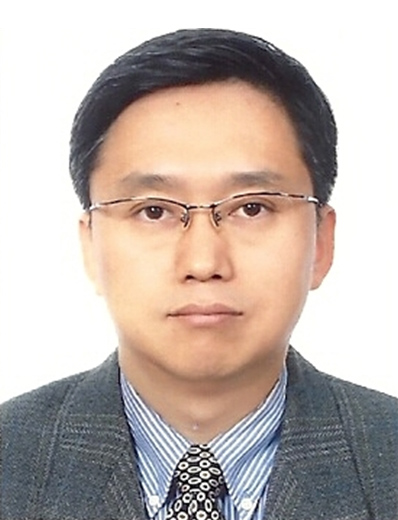 |
Dr. Shin said, "Through the ongoing research on the effects of 50 frequently-used Korean herbal prescriptions on drug metabolizing enzymes, we will contribute to predicting risks in combined usage of Korean and Western medicine and to improving treatment effects."
|

|


|
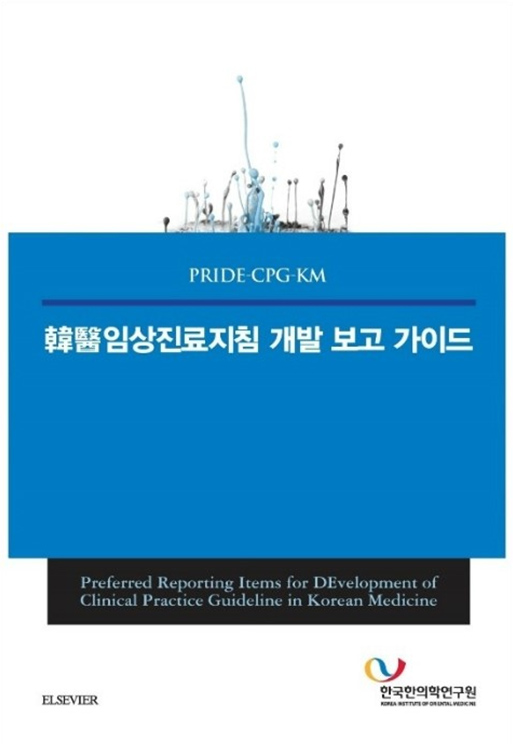 |
Principal Researcher Lee Myeong Soo and his team of KIOM has developed the Guide for Development of Clinical Practice Guidelines in Korean Medicine.
Clinical practice guidelines (CPG) refers to guidelines systematically developed to support the decision making by clinical doctors and patients in specific conditions. In countries where advanced medical practices are carried out, such as the U.S., U.K. and Canada, a lot of efforts are being made for the development of CPG under the recognition of its utility and values, and similar attempts have been made in the domestic medical circles for the development and expansion of CPG. According to the list of CPG registered in the Korean Medical Guideline Information Center (www.guideline.or.kr) and the Korean Guideline Clearinghouse (www.cpg.or.kr) in 2014, there are about 60 kinds of CPG already developed in the Korean medical circles. |
In the field of Korean Medicine, 16 kinds of CPG have been developed up to the present. However, the lack of standardization among them can lead to confusion in utilizing them in the clinical sites.
The new guide was developed by Dr. Lee's team to facilitate development of high-quality CPG based on the experience and knowhow accumulated by the team when it developed its CPG in Korean Medicine on frequent diseases in 2013.
The guide, published in Korean, consists of four parts including the introduction and usage tips, development tools for CPG in Korean Medicine, guide checklist for developing CPG in Korean Medicine and terms related to CPG.
The first part on the introduction and usage tips presents specific goals of developing the guide as well as its composition and contents.
The second part on the development tools of CPG shows the development methodology, overview of diseases, recommendations, etc.
The third part presents the checklist that developers can refer to see whether their new guidelines includes all necessary contents, and the last part offers terms commonly used in CPG and their definitions.
The new Guide for Development of Clinical Practice Guidelines in Korean Medicine is expected to enable development of high-quality CPG in Korean medicine that offer effective diagnosis and treatment methods based on accurate and systematic analysis.
In addition, it is anticipated that the guide will improve understanding of evidence-based medicine in the Korean medical circles, contributing to the development of the field, and accelerate provision of more systematic Korean healthcare services to the public.
The new guide was developed by Dr. Lee's team to facilitate development of high-quality CPG based on the experience and knowhow accumulated by the team when it developed its CPG in Korean Medicine on frequent diseases in 2013.
The guide, published in Korean, consists of four parts including the introduction and usage tips, development tools for CPG in Korean Medicine, guide checklist for developing CPG in Korean Medicine and terms related to CPG.
The first part on the introduction and usage tips presents specific goals of developing the guide as well as its composition and contents.
The second part on the development tools of CPG shows the development methodology, overview of diseases, recommendations, etc.
The third part presents the checklist that developers can refer to see whether their new guidelines includes all necessary contents, and the last part offers terms commonly used in CPG and their definitions.
The new Guide for Development of Clinical Practice Guidelines in Korean Medicine is expected to enable development of high-quality CPG in Korean medicine that offer effective diagnosis and treatment methods based on accurate and systematic analysis.
In addition, it is anticipated that the guide will improve understanding of evidence-based medicine in the Korean medical circles, contributing to the development of the field, and accelerate provision of more systematic Korean healthcare services to the public.

|
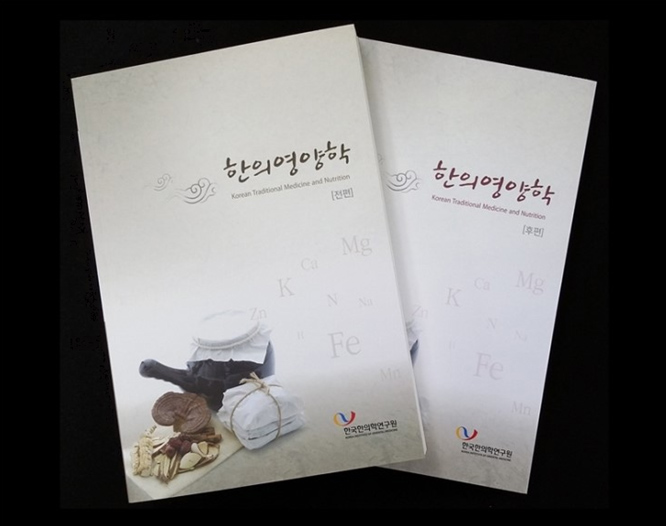 |
Korea is in the middle of a food-show fever right now, which has increased people's interest in healthy diets and eating habits. In step with this trend, a book series on modern nutritional science seen from the perspective of Korean Medicine has been published in Korean.
Notably, the series offers easy daily diets used in Korean and Western medicine for patients of high blood pressure, hyperlipidemia, diabetes, etc., and is expected to provide a health guide for contemporary people. |
Principal Researcher Ko Byoung Seob, Director of the KM Convergence Research Division at KIOM, published 'Korean Medicine and Nutrition', a book series that examines modern nutritional science and clinical nutrition from the perspective of Korean Medicine and facilitates application of healthy diets to daily life.
'Korean Medicine and Nutrition'was written by Dr. Ko who has compiled materials on Korean Medicine and modern nutritional science that he accumulated for 12 years after starting a small group study in 2003.
The book series, which attempted at a new convergence through the encounter and communication between the two fields, consists of two books.
The first book comprising eight chapters describes the perspective of Korean Medicine on nutrition as well as the similarities and differences between the perspectives of traditional medicine and modern nutritional science.
The second book consisting of three chapters deals with how to apply Korean Medicine to nutritional diets and the comparison of diets in Korean and Western medicine for patients of various diseases.
It is expected that 'Korean Medicine and Nutrition'will help promote healthy living of the public through daily application as well as an opportunity for those majoring in nutritional science and Korean Medicine to examine modern nutritional science and clinical nutrition from the perspective of traditional medicine.
'Korean Medicine and Nutrition'was written by Dr. Ko who has compiled materials on Korean Medicine and modern nutritional science that he accumulated for 12 years after starting a small group study in 2003.
The book series, which attempted at a new convergence through the encounter and communication between the two fields, consists of two books.
The first book comprising eight chapters describes the perspective of Korean Medicine on nutrition as well as the similarities and differences between the perspectives of traditional medicine and modern nutritional science.
The second book consisting of three chapters deals with how to apply Korean Medicine to nutritional diets and the comparison of diets in Korean and Western medicine for patients of various diseases.
It is expected that 'Korean Medicine and Nutrition'will help promote healthy living of the public through daily application as well as an opportunity for those majoring in nutritional science and Korean Medicine to examine modern nutritional science and clinical nutrition from the perspective of traditional medicine.


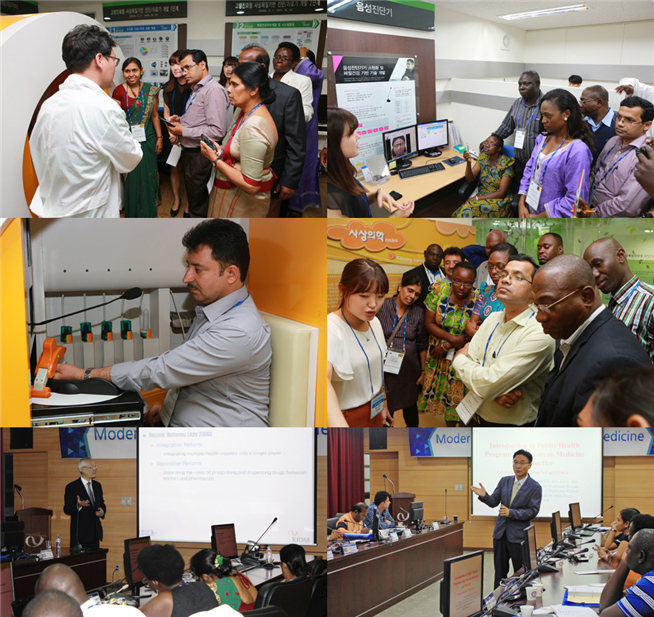
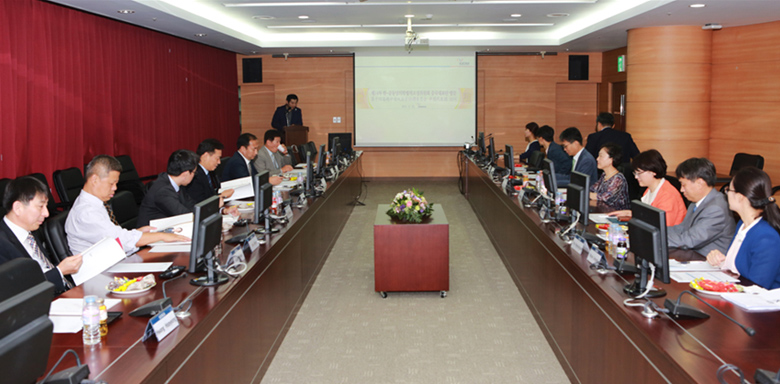

infertility based on Korean Medicine | |||||||||||||||||||
|
KIOM held a seminar commemorating its 21st anniversary on the theme of 'Korean Medical Approach for Treatment of Infectious Diseases and Infertility'on October 7.
Recently, infectious diseases, such as severe acute respiratory syndrome (SARS), Ebola virus, and Middle East respiratory syndrome (MERS), have become key issues throughout the world. With a WHO report recognizing the effect of a treatment method based on Chinese traditional medicine introduced by the Chinese government during the SARS epidemic in 2003, the efficacy of traditional medical treatment on infectious diseases is drawing keen attention. Also, as late marriages and childbirth by older mothers are becoming more common due to changed attitude on marriage, childbirth, and child rearing, the problem of infertility is continuously becoming more serious. In relation to this, people are getting more interested in the treatment of infertility based on Korean Medicine, and a lot of research is being carried out in relevant areas. In the seminar commemorating KIOM's 21st anniversary, discussion on diagnosis, prevention and treatment of infectious diseases and infertility based on Korean Medicine was made as well as an overview of current research trends and a search for the future direction of research on these issues. The seminar was jointly organized by KIOM, the Association of Korean Medicine and the Society of Korean Medicine, and was sponsored by the Ministry of Science, ICT and Future Planning, the Ministry of Health and Welfare and the National Research Council of Science and Technology. The seminar was held in two sessions, each on infectious diseases and infertility. During the session on infectious diseases, presentation was made on such issues as 'New Threats of Infectious Diseases and Response Measures'by Director Seong Won-geun of the Center of Infectious Diseases in the National Research Institute of Health affiliated to the Centers for Disease Control and Prevention; 'Infectious Diseases and Korean Medicine'by Prof. Jeong Seung-gi of Kyung Hee University; 'A New Look at Infectious Diseases from the Perspective of Korean Medicine'by Honorary President Choi Hwan-young of the Association of Korean Medicine; and 'A Study on the Anti-viral Effect of KIOM-C Based on Natural Medicinal Herbs'by Principal Researcher Cho Won-kyung of KIOM. In the session on infertility, Senior Researcher Hwang Na-mi from the Korea Institute for Health and Social Affairs talked about 'Current Status of and Management Strategy for Infertility in the Age of Low Fertility'; Prof. Kim Dong-il from Dongguk University on 'Current Conditions of Infertility Treatment and Search for Future Strategy for Building Clinical Grounds'; Prof. Choi Chang-min from Wonkwang University on 'Basic Survey for Developing Diagnostic Criteria in Korean Medicine'; Prof. Hwang Deok-sang from Kyung Hee University on 'Analysis of Research Trends in Treatment of Infertility in Korean Medicine'; and Senior Researcher Yoo Su-seong from KIOM on 'Integrative Treatment of Infertility Combining Korean Traditional and Western Medicine.' Through the discussion held after these sessions, presenters and participants shared opinions on the future directions of research on infectious diseases and infertility as well as possible research cooperation. |

Experts in development of CPG invited to a KIOM symposium
KIOM has held the symposium since 2012 to gather ideas from Korean and foreign experts on CPG and to share opinions on the current status and future direction of research related to CPG.
In the symposium, experts in integrative medicine from both Korea and foreign countries such as China -which won the 2015 Nobel Prize in Physiology or Medicine- as well as Japan and Norway participated to share their opinions on the newest research in the field. |
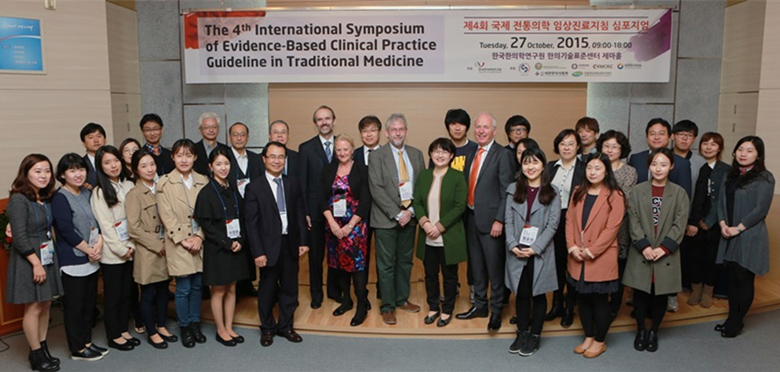
|
Dr. Robbert van Haselen from the International Institute for Integrated Medicine in the U.K. delivered the keynote speech on 'Gap between research and practice.'
In the first session chaired by Prof. Nicola Robinson from London South Bank University, presentations were made by Prof. Jianping Liu from Centre for Evidence-Based Chinese Medicine, and School of Basic Medical Science at Beijing University of Chinese Medicine, on the 'Evidence Base for Recommendation in TCM and Western Medicine Guidelines for 18 diseases'and Prof. Terje Alraek from UiT The Artic University of Norway on 'Exploration of the risk of bias against acupuncture implicit in sham acupuncture trials: impact on systematic reviews and clinical practical guideline(CPG) development groups and CPG recommendations about acupuncture;'Prof. Stephen J. Birch from the Norwegian School of Health Sciences, Institute of Acupuncture, Kristiania University College in Norway talked 'Update of positive recommendation for the use of acupuncture treatment.' In the second session, which was held in the afternoon under the chairmanship of Prof. Jianping Liu, a presentation was given by Prof. Nicola Robinson on 'Is research evidence important for clinical guideline?;'Prof. Masayo Kojima of the Nagoya City University Graduate School of Medical Sciences in Japan on 'Findings from comprehensive survey of living conditions in Japan: Using observational study in CPG development for traditional medicine'and Prof. Zhou Li from Dongzhimen Hospital Affiliated to Beijing University of Chinese Medicine on 'The survey of the knowledge of prevention and treatment of TCM against NCDs in Beijing North Dongcheng District Community Residents.' In the third session chaired by Prof. Stephen J Birch, presentations were made by Senior Researcher Lee Ju-ah from the KM Fundamental Research Division in KIOM on 'Preferred reporting items for development of clinical practice guideline in Korean Medicine;'Prof. Shin Byung-cheul from Pusan National University Korean Medicine Hospital on 'Development of evidence based Korean medicine clinical practice guideline for lumbar herniated intervertebral disc and shoulder pain'and Principal Researcher Lee Myeong Soo from the Clinical Research Division of KIOM on 'Overview of project of development of evidence based clinical practice guideline in Korean medicine (2012-2015).' The symposium, which offers an opportunity to hear about the methods of CPG development and relevant knowhow from domestic and foreign experts in CPG, would contribute to the development of high-quality CPG in Korean Medicine. |


|
 |
Integrative Medicine Research (IMR) an international journal published by KIOM on the theme of integrative medicine, was selected as a candidate for the National Research Foundation of Korea's list of academic journals. The selection is considered to indicate its recognition as a distinguished academic journal and its establishment as a leading English journal on Korean medicine.
Since the first issue of IMR was published in December 2012, KIOM has brought out 11 issues of the quarterly journal. |
The number of downloads of IMR papers on Science Direct has steadily increased from 24 in 2012 to 3,025 in 2013 and 8,235 in 2014.
At present, researchers from around the world including Korea, Asian countries such as China, India, and Iran, North American countries including the U.S. and Canada, European countries such as the U.K., Denmark, France, and Portugal as well as Australia have contributed their papers to IMR.
There are 47 members working on the evaluation of papers, etc. on the editorial board of IMR, whose nationalities are widely distributed around the world. Among them, 24 are from Korea, nine are from Asian countries such as China and Japan, seven are from Europe, four are from North America and three are from Oceania.
The publication rate of papers in IMR is 65.1%, while the rejection rate is 34.9%.
The number of SCI(E)-level journals in integrative and complementary medicine around the world is 24 at present and is rising. There is no SCI-level international journal in Korean medicine published in Korea.
At present, researchers from around the world including Korea, Asian countries such as China, India, and Iran, North American countries including the U.S. and Canada, European countries such as the U.K., Denmark, France, and Portugal as well as Australia have contributed their papers to IMR.
There are 47 members working on the evaluation of papers, etc. on the editorial board of IMR, whose nationalities are widely distributed around the world. Among them, 24 are from Korea, nine are from Asian countries such as China and Japan, seven are from Europe, four are from North America and three are from Oceania.
The publication rate of papers in IMR is 65.1%, while the rejection rate is 34.9%.
The number of SCI(E)-level journals in integrative and complementary medicine around the world is 24 at present and is rising. There is no SCI-level international journal in Korean medicine published in Korea.
 |
KIOM President Lee Hyejung noted, "With the selection of IMR as a candidate for the National Research Foundation of Korea's list of academic journals, we plan to focus our efforts on developing the journal into an SCI-level international journal. KIOM will continue to promote the academic excellence of the research in Korean Medicine and contribute to improving the international competitiveness of Korean medicine."
|
Papers published in IMR can be viewed and downloaded from its homepage (www.imr-journal.com/) as well as academic search systems including Korea Citation Index, Google Scholar, Science Direct.
* Article Submission for IMR Vol.5 No.2
IMR Vol.5 No.2, which will be published in June, 2016, is the special issue with the theme of 'Multidisciplinary study of Sasang Constitutional Medicine'. The theme of the article should be related to psychology, society, media, culture, sports, literature, art, music, philosophy, biology, etc. of Sasang Constitutional Medicine. The article can be submitted through the IMR website (http://ees.elsevier.com/imr) by 15th January, 2016. Please contact IMR staff through email (imr@kiom.re.kr) for more information.

|

|

|
||
|
KOREA INSTITUTE OF ORIENTAL MEDICINE
1672 Yuseong-daero, Yuseong-gu, Daejeon, 34054, Republic of Korea Tel. +82-42-868-9477 Fax. +82-42-868-9616 |
